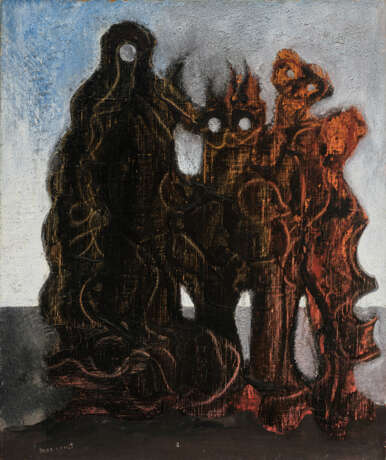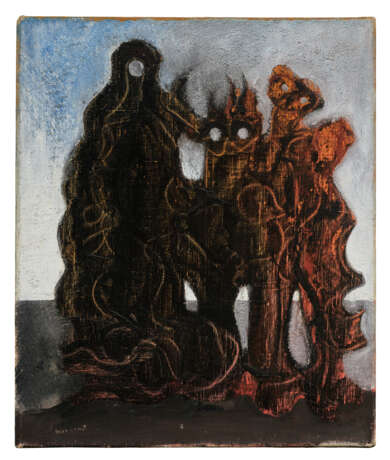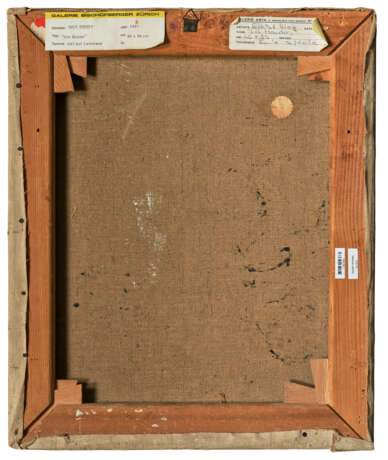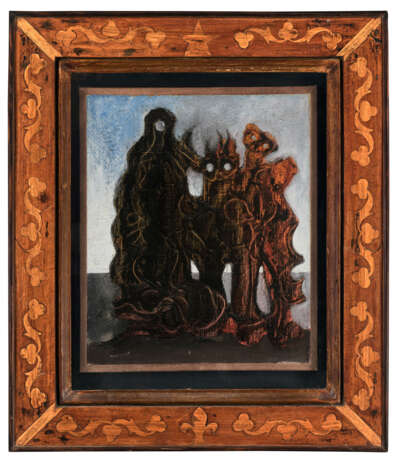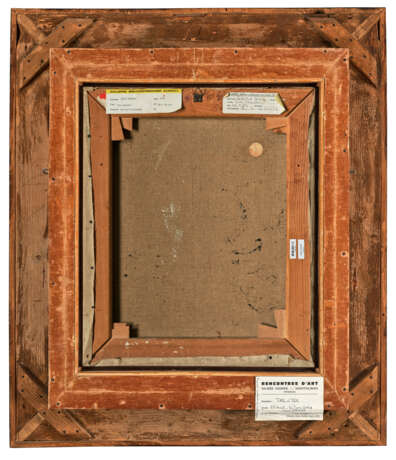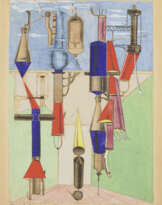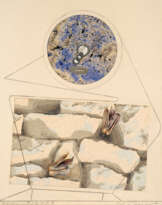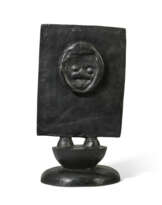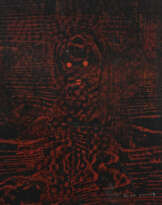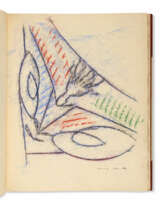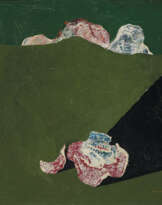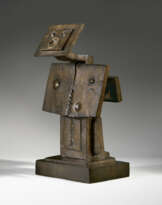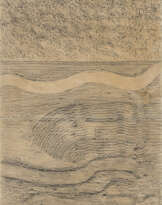ID 1302079
Lot 54 | Max Ernst (1891-1976)
Estimate value
€ 350 000 – 550 000
La Horde
signé ‘max ernst’ (en bas à gauche)
huile sur toile
46.5 x 38.8 cm.
Peint en 1927
signed 'max ernst' (lower left)
oil on canvas
18 3/8 x 15 ¼ in.
Painted in 1927
Provenance
Galerie Jacqueline de Jong, Pays-Bas.
Collection particulière, Suisse.
Thomas Gibson Fine Art Ltd, Londres (en 1972).
Helen Serger, La Boetie Inc., New York (en 1972).
Fisher Fine Art, New York (avant 1976).
Galerie Bischofberger, Zurich.
Galerie Arta, Genève.
Galerie Melki, Paris.
Acquis auprès de celle-ci en juillet 1978.
Literature
W. Spies, S. et G. Metken, Max Ernst, Werke, 1925-1929, Cologne, 1976, p. 164, no. 1110 (illustré).
Exhibited
Londres, Thomas Gibson Fine Art Ltd, Catalogue collection, été 1972 (illustré).
New York, Helen Serger, La Boetie, Inc., Paintings-Drawings-Watercolors and Prints by 20th Century Masters, automne 1972, no. 4 (illustré en couleurs).
Montauban, Musée Ingres, Tête à tête, avril-juin 2004, p. 43 (illustré en couleurs).
Lille, Musée de l’Hospice Comtesse, Hypnos, Images et inconscients en Europe (1900-1949), mars-juillet 2009, p. 129 et 314, no. 104 (illustré en couleurs).
Further Details
« Max Ernst est mort le 1er août 1914. Il est revenu à la vie le 11 novembre 1918, comme un jeune homme qui voulait être magicien et trouver le mythe de son époque ».
M. Ernst, ‘Some Data on the Youth of M. E. as Told by Himself’, in View, avril 1942, No. 1, p. 30.
La Horde, véritable vision cauchemardesque et prophétique, est l'une des toutes premières œuvres réalisées par Max Ernst en 1927 grâce à la technique révolutionnaire du grattage mise au point la même année. Appliquant la logique du frottage à la peinture, Ernst gratte le pigment et la peinture encore humide déposée sur la toile pour créer une surface texturée et évoquer des formes organiques qu’il définit et améliore ensuite au pinceau. Les trois personnages monstrueux de la présente œuvre, dont les silhouettes mutantes constituées d’excroissances et d’amas de boue se détachent dans un ciel bleu pâle nuancé de gris, semblent avoir été magiquement conjurées et invoquées. Leurs yeux constituent des ouvertures vides sur le ciel, uniques punctum lumineux de la composition. Dans son étude sur les mécanismes de la suggestion dans l’art, Paul Souriau explique ce phénomène comme « la fascination par l’éclat » ; un principe qui consiste à installer au cœur de la composition un disque ou une source lumineuse qui contraste avec le milieu ambiant pour concentrer le regard et assurer sa fixité sur une « tache ». Le regard hypnotique de ces figures entre en résonance avec les expériences de somnambulisme et de spiritisme qui placent Ernst dans un état comparable à celui du demi-sommeil et lui permettent d’enrichir ses facultés visionnaires.
Cette image de maraude et de barbarie fait partie d’une série exécutée en 1927 par Ernst, alors épris de visions mystérieuses et inquiétantes. Elle est étroitement liée à son homonyme, La Horde, conservée au Stedelijk Museum d’Amsterdam ou encore à La Famille nombreuse donnée par Peggy Guggenheim au San Francisco Museum of Modern Art, toutes deux peintes en 1927. En improvisant ses gestes sur ses toiles, Ernst fait ici surgir de son subconscient des souvenirs cauchemardesques de la Première Guerre mondiale. Ses angoisses d’après-guerre se manifestent sous la forme de barbares et de maraudeurs mythiques ressuscitant de la boue des Flandres. La réapparition de ces figures, d’une beauté menaçante, dans l’art de Max Ernst en 1927 n’est pas anodine mais plutôt prémonitoire voire dénonciatrice. Ce dernier, comme de nombreux artistes ayant vécu la fournaise de la Grande Guerre, voient dans l’avènement d’Hitler et la montée du nazisme dans leur Allemagne natale, la perspective d’une nouvelle guerre européenne et s’engagent à rappeler à leur semblables les horreurs et les dévastations de celle-ci. Avec la présente Horde, Ernst utilise cette magie divinatoire pour mettre en lumière les montres qui hantent ses souvenirs et créer une image de l’inconscient collectif de son époque.
L’année 1927 constitue ainsi une période prolifique dans l’œuvre de Max Ernst, travaillant sur plusieurs séries simultanément. La série des Oiseaux domine cette période, ce motif apparaissant dans presque toutes ses peintures. La Horde ne fait pas exception à la règle puisqu’on y distingue la silhouette d’un oiseau de profil dans la masse de terre qui constitue le corps du barbare au centre de la composition. Il s’agit possiblement d’une incarnation avant-coureuse du futur alter ego de Ernst, son Doppelgänger qu’il nommera à partir de 1930 « Loplop, le supérieur des oiseaux ».
“Max Ernst died on August 1, 1914. He came back to life on November 11, 1918, as a young man who wanted to be a magician and find the myth of his time” (M. Ernst, ‘Some Data on the Youth of M. E. as Told by Himself,’ in View, April 1942, No. 1, p. 30).
La Horde a profoundly nightmarish and prophetic vision, is one of the very first works created by Max Ernst in 1927 using the revolutionary grattage technique he developed that same year. Adapting the technique of frottage to painting, Ernst scraped the pigment and still-wet paint from the canvas to create a textured surface and evoke organic forms, which he then defined and enhanced with a brush.The three monstrous figures in the present work, with their mutant silhouettes composed of excrescences and lumps of mud, stand out against a pale blue sky tinged with gray, appearing to be magically conjured and summoned. Their eyes appear as vacant portals to the sky, the only luminous punctum in the composition. In his study on the mechanisms of suggestion in art, Paul Souriau explains this phenomenon as "fascination by brilliance"; a principle that involves placing a disc or a light source in the heart of the composition, contrasting with the surrounding environment to focus the gaze and ensure its fixation on a "spot." The hypnotic gaze of these figures resonates with the experiences of somnambulism and spiritism, placing Ernst in a state comparable to semi-sleep and allowing him to enrich his visionary faculties.
This image of marauding and barbarism is part of a series executed by Ernst in 1927, during a period of mysterious and unsettling visions. It is closely related to its namesake, La Horde, housed in the Stedelijk Museum in Amsterdam, and La Famille nombreuse, donated by Peggy Guggenheim to the San Francisco Museum of Modern Art, both painted in 1927. By improvising his gestures on his canvases, Ernst conjures from his subconscious the nightmarish memories of World War I. His post-war anxieties manifest as mythical barbarians and marauders resurrecting from the mud of Flanders. The reappearance of these figures, with their threathening beauty, in Ernst's art in 1927 is not coincidental but rather premonitory , if not denunciatory. Like many artists who experienced the inferno of the Great War, Ernst saw the rise of Hitler and the ascent of Nazism in their native Germany as the prospect of another European war, and they endeavored to remind their contemporaries of its horrors and devastations. With the present Horde, Ernst uses this divinatory magic to highlight the monsters haunting his memories and to create an image of the collective unconscious of his time.
The year 1927 was thus a prolific period in Max Ernst's work, as he worked on several series simultaneously. The Birds series dominates this period, with this motif appearing in almost all his paintings. La Horde is no exception, as one can discern the silhouette of a bird in profile within the mass of earth that forms the body of the barbarian at the center of the composition. This may be an early incarnation of Ernst's future alter ego, his Doppelgänger, which he would later name "Loplop, the Superior of Birds" starting in 1930.
| Artist: | Max Ernst (1891 - 1976) |
|---|---|
| Applied technique: | Oil on canvas |
| Auction house category: | Paintings, Watercolors, Drawings, Paintings |
| Artist: | Max Ernst (1891 - 1976) |
|---|---|
| Applied technique: | Oil on canvas |
| Auction house category: | Paintings, Watercolors, Drawings, Paintings |
| Address of auction |
CHRISTIE'S 8 King Street, St. James's SW1Y 6QT London United Kingdom | |
|---|---|---|
| Preview |
| |
| Phone | +44 (0)20 7839 9060 | |
| Buyer Premium | see on Website | |
| Conditions of purchase | Conditions of purchase |
